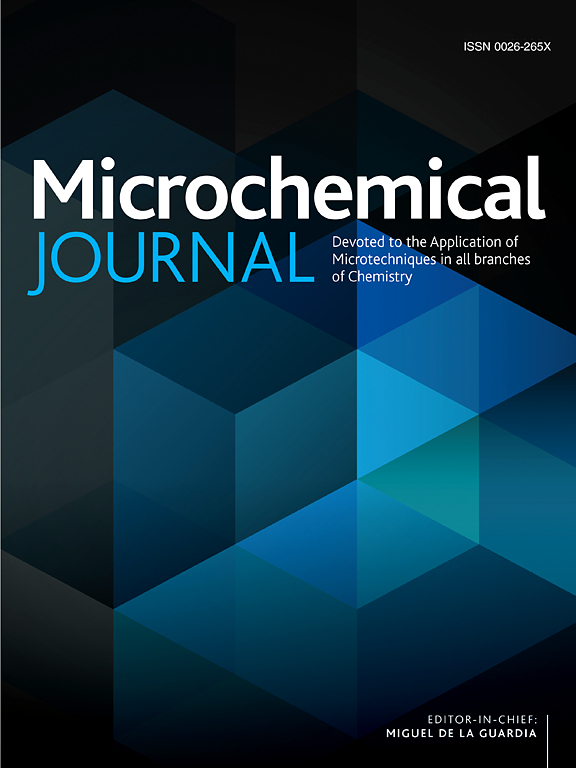改良ASAP-MS技术在植物微样品直接分析中的应用及其在单粒花粉化学表征中的潜力
IF 4.9
2区 化学
Q1 CHEMISTRY, ANALYTICAL
引用次数: 0
摘要
在现代科学和实践中,对植物材料进行微尺度的直接化学分析是非常需要的,但目前还没有完全开发出可靠的方法来满足当前的需求。分析程序需要对样品处理进行先进的显微控制,随后转移到分析和高度敏感的显微分析技术和方法,而这些技术和方法在分析实验室中尚未建立。显然,在植物代谢组学和单细胞分析中,开发基于新型显微操作方法与直接质谱法相结合的复杂方法是非常必要的。结果利用改性玻璃毛细管的大气固体分析探针质谱法(ASAP-MS)可作为直接分析植物显微样品的新工具。在标准纯碱玻璃毛细管上交叉钻一个小孔,将固体样品插入毛细管,放入离子源中进行asa - ms分析。这种方法可以直接、快速、灵敏地分析植物微样品中的甾醇。环离子迁移率的应用使选择的酚类化合物在豌豆种皮碎片分离,从而其可靠的鉴定。改良的ASAP-MS技术和显微控制下的电子驱动显微操作采样相结合,可以对分离的花粉粒进行分析。鉴定了植物花粉的生物标志物,探讨了松生植物和厚朴植物花粉的化学差异。鉴定出的脂肪酸、脂肪醇及其酯类、甾醇脂类、植物甾醇以及与植物甾醇和萜类脂肪酸的酯类的归一化强度在厚朴植物中显著较高。意义:开发的方法允许分析单个花粉粒中的脂肪化合物。在植物系统发育的背景下,ASAP-MS为所研究花粉种类的化学成分提供了新的信息。获得的数据有助于理解种子和花粉表面结构的化学稳定性和特性。电子驱动样品显微操作与asp - ms相结合被证明是微代谢组学研究的合适方法。本文章由计算机程序翻译,如有差异,请以英文原文为准。
Application of modified ASAP-MS technique for direct analysis of plant microsamples and its potential for single pollen grain chemical characterization
Background
Direct chemical analysis of plant material in microscale is highly requested in modern science and practice but reliable procedures covering current needs are not fully developed yet. Analytical procedures require advanced microscopic control of sample treatment, consequent transfer to analysis and highly sensitive micro-analytical techniques and methods that are not established in analytical laboratories. Obviously, development of complex procedures based on suitable combination of novel micromanipulation procedures with direct mass spectrometry is highly requested in plant metabolomics and single cell analysis.
Results
Atmospheric solids analysis probe mass spectrometry (ASAP-MS) using modified glass capillaries was used as a novel tool for the direct analysis of plant microsamples. A small hole was cross-drilled into standard soda glass capillary tube, solid sample was inserted into the capillary, and it was placed into the ion source for ASAP-MS analysis. This approach allows direct, fast and sensitive sterol profiling in plant microsamples. Application of cyclic ion mobility enabled separation of selected phenolic compounds and consequently their reliable identification in pea seed coat fragments. A combination of the modified ASAP-MS technique and electronically driven micromanipulation sampling under microscopic control allowed analysis of separated pollen grains. Biomarkers of pollen species were identified and chemical differences among pinophyta and magnoliophyta were explored. Normalized intensities of identified fatty acids, fatty alcohols and their esters, sterol lipids, phytosterols and esters of fatty acids with phytosterols and terpenoids were significantly higher in magnoliophyta.
Significance
Developed procedure allowed analysis of fatty compounds in single pollen grains. ASAP-MS provided new information about chemical composition of studied pollen species in context with plant phylogeny. Obtained data contribute to understanding of chemical stability and properties of seed and pollen surface structures. Combination of electronically driven sample micromanipulation with ASAP-MS proved to be suitable procedure for micro-metabolomic studies.
求助全文
通过发布文献求助,成功后即可免费获取论文全文。
去求助
来源期刊

Microchemical Journal
化学-分析化学
CiteScore
8.70
自引率
8.30%
发文量
1131
审稿时长
1.9 months
期刊介绍:
The Microchemical Journal is a peer reviewed journal devoted to all aspects and phases of analytical chemistry and chemical analysis. The Microchemical Journal publishes articles which are at the forefront of modern analytical chemistry and cover innovations in the techniques to the finest possible limits. This includes fundamental aspects, instrumentation, new developments, innovative and novel methods and applications including environmental and clinical field.
Traditional classical analytical methods such as spectrophotometry and titrimetry as well as established instrumentation methods such as flame and graphite furnace atomic absorption spectrometry, gas chromatography, and modified glassy or carbon electrode electrochemical methods will be considered, provided they show significant improvements and novelty compared to the established methods.
 求助内容:
求助内容: 应助结果提醒方式:
应助结果提醒方式:


